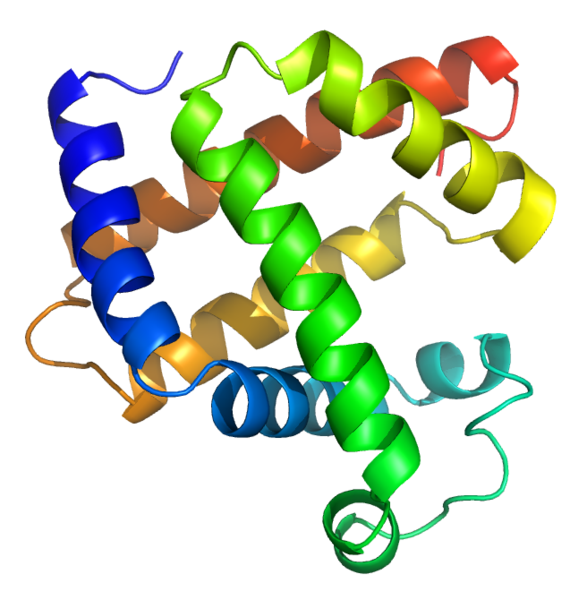|
|
| (10 intermediate revisions by one other user not shown) |
| Line 8: |
Line 8: |
| Caption = Model of helical domains in myoglobin. | | | Caption = Model of helical domains in myoglobin. | |
| }} | | }} |
| {{SI}}
| |
| {{CMG}}; {{AE}} {{AKS}}; {{VSKP}} | | {{CMG}}; {{AE}} {{AKS}}; {{VSKP}} |
|
| |
|
|
| |
|
| ==[[Myoglobinuria overview|Overview]]== | | ==[[Myoglobinuria overview|Overview]]== |
|
| |
|
| |
| [[Myoglobinuria]] is the presence of [[myoglobin]] in the urine, usually associated with [[rhabdomyolysis]] or muscle destruction.
| |
|
| |
| *[[Myoglobin]] ('''Mb''' or '''MB''') is an [[iron- and oxygen-binding protein]] found in [[muscles]]. Myoglobin is present in [[muscle]] cells as a reserve of [[oxygen]].In humans, myoglobin is only found in the bloodstream after muscle injury. It is an abnormal finding, and can be diagnostically relevant when found in blood.<ref name=Nelson00>{{cite book | author = Nelson DL, Cox MM | title = Lehninger Principles of Biochemistry | publisher = Worth Publishers | location = New York | year = 2000 | page = 206 | edition = 3rd | isbn = 0-7167-6203-X | url=https://books.google.com/books?id=5Ek9J4p3NfkC&dq=nelson+2000+Lehninger+Principles+of+Biochemistry&q=myoglobin}} (Google books link is the 2008 edition)</ref>
| |
|
| |
| *Myoglobin is the primary [[oxygen]]-carrying [[biological pigment|pigment]] of muscle tissues.<ref name="review">{{cite journal | vauthors = Ordway GA, Garry DJ | title = Myoglobin: an essential hemoprotein in striated muscle | journal = The Journal of Experimental Biology | volume = 207 | issue = Pt 20 | pages = 3441–6 | date = Sep 2004 | pmid = 15339940 | doi = 10.1242/jeb.01172 }}</ref> High concentrations of myoglobin in muscle cells allow organisms to hold their breath for a longer period of time. Diving mammals such as whales and seals have muscles with particularly high abundance of myoglobin.<ref name=Nelson00/> Myoglobin is found in Type I muscle, Type II A and Type II B, but most texts consider myoglobin not to be found in [[smooth muscle tissue|smooth muscle]].
| |
|
| |
| ==References==
| |
| {{Reflist|2}}
| |
| {{WH}}
| |
| {{WS}}
| |
| [[Category: (name of the system)]]
| |
|
| |
|
| ==[[Myoglobinuria historical perspective|Historical Perspective]]== | | ==[[Myoglobinuria historical perspective|Historical Perspective]]== |
|
| |
| Myoglobin was the first protein to have its three-dimensional structure revealed by [[X-ray crystallography]].<ref>[https://www.nsf.gov/news/news_summ.jsp?cntn_id=100689 (U.S.) National Science Foundation: Protein Data Bank Chronology (Jan. 21, 2004)]. Retrieved 3.17.2010</ref> This achievement was reported in 1958 by [[John Kendrew]] and associates.<ref name="architecture">{{cite journal | vauthors = Kendrew JC, Bodo G, Dintzis HM, Parrish RG, Wyckoff H, Phillips DC | title = A three-dimensional model of the myoglobin molecule obtained by x-ray analysis | journal = Nature | volume = 181 | issue = 4610 | pages = 662–6 | date = Mar 1958 | pmid = 13517261 | doi = 10.1038/181662a0 | bibcode = 1958Natur.181..662K }}</ref> For this discovery, John Kendrew shared the 1962 [[Nobel Prize in chemistry]] with [[Max Perutz]].<ref name="nobel">[http://nobelprize.org/chemistry/laureates/1962/index.html The Nobel Prize in Chemistry 1962]</ref> Despite being one of the most studied proteins in biology, its physiological function is not yet conclusively established: mice genetically engineered to lack myoglobin can be viable and fertile but show many cellular and physiological adaptations to overcome the loss. Through observing these changes in myoglobin-deplete mice, it is hypothesised that myoglobin function relates to increased oxygen transport to muscle, oxygen storage and as a scavenger of [[reactive oxygen species]].<ref name="mice-function">{{cite journal | vauthors = Garry DJ, Kanatous SB, Mammen PP | title = Molecular insights into the functional role of myoglobin | journal = Advances in Experimental Medicine and Biology | volume = 618 | pages = 181-93 | date = 2007 | pmid = 18269197 | doi = 10.1007/978-0-387-75434-5_14 }}</ref>
| |
|
| |
|
| |
| ==References==
| |
| {{Reflist|2}}
| |
| {{WH}}
| |
| {{WS}}
| |
| [[Category: (name of the system)]]
| |
|
| |
|
| ==[[Myoglobinuria classification|Classification]]== | | ==[[Myoglobinuria classification|Classification]]== |
| Line 42: |
Line 19: |
| ==[[Myoglobinuria pathophysiology|Pathophysiology]]== | | ==[[Myoglobinuria pathophysiology|Pathophysiology]]== |
|
| |
|
| ==[[Myoglobinuriacauses|Causes]]== | | ==[[Myoglobinuria causes|Causes]]== |
|
| |
|
| ==[[Myoglobinuria differential diagnosis|Differentiating Lead poisoning from other Diseases]]== | | ==[[Myoglobinuria differential diagnosis|Differentiating Myoglobinuria from other Diseases]]== |
|
| |
|
| ==[[Myoglobinuria epidemiology and demographics|Epidemiology and Demographics]]== | | ==[[Myoglobinuria epidemiology and demographics|Epidemiology and Demographics]]== |
